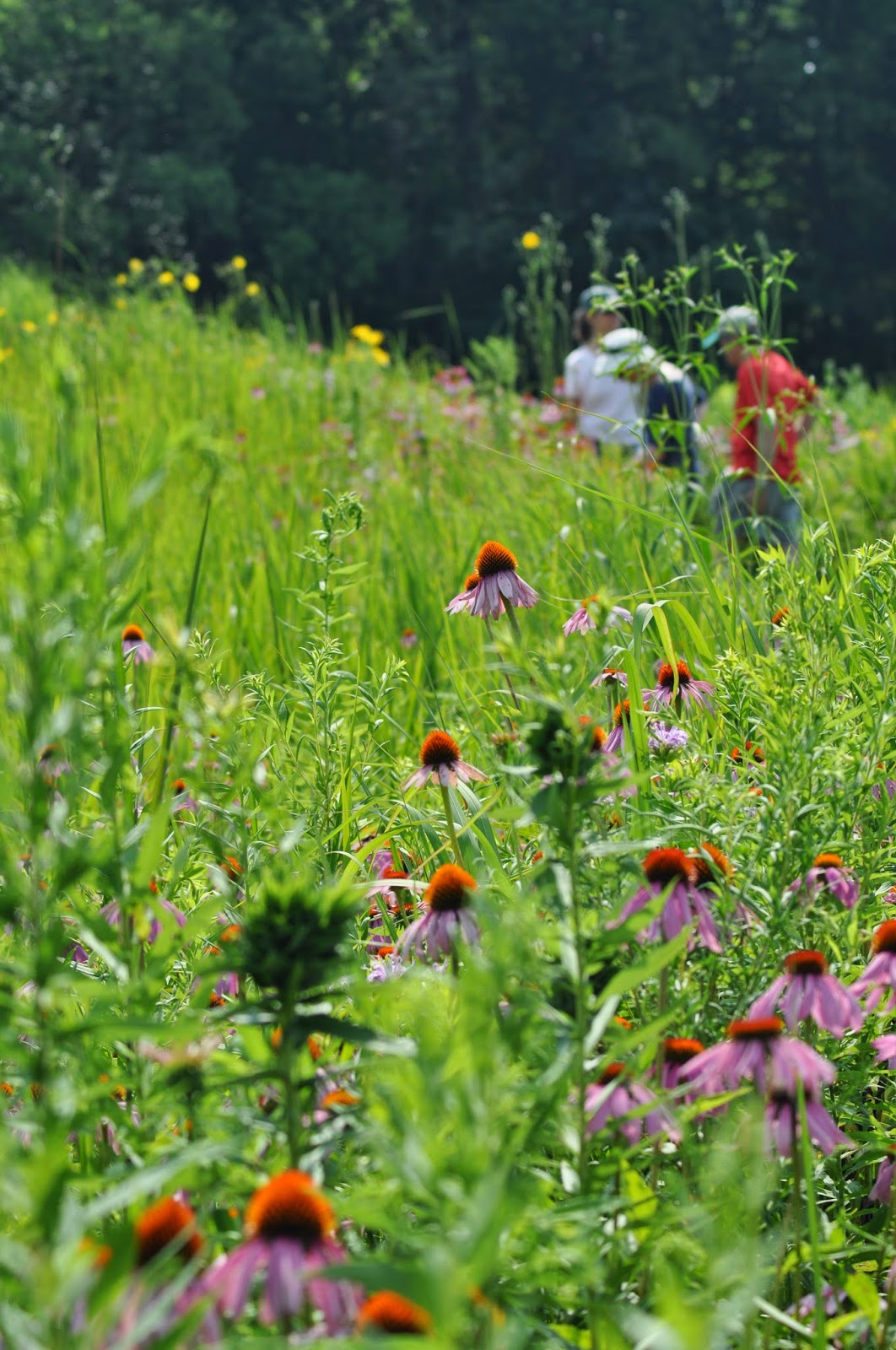I finally made it to Guy Denny’s prairie in Fredericktown and boy was it worth it! A riot of colors, including red cardinal and royal catchfly flowers; orange/yellow ox-eye daisies; yellow sunflowers, senna, prairie dock, and compass plant flowers; pink marsh mallow flowers; white culver’s-root and rattlesnake master flowers; red-pink ironweed flower; pink coneflowers and Queen-of-the-Prairie; and tall blue larkspur flowers.
It seemed like each flower had at least one bee on it, not to mention beetles, butterflies, and other pollinators.
Just driving to the parking for the tour was an adventure and thrill, driving a one-lane path a long way off of Route 95. There I was welcomed by the group, the prairie, and two cats.
Denny created the prairie on one side of the path we walked 10 years ago and the prairie on the other side about 6 years ago, Ray Heithaus said. Ray, professor emeritus of environmental science and biology at Kenyon College, led the tour, substituting for Denny. His wife Pat, a retired Kenyon biology instructor, helped the group with plant identification. Denny retired from the Ohio Department of Natural Resources.
Ray said that Denny maintains the prairie by annual controlled burning, which involves techniques that lead to a low temperature burn that does not reach underground to plant roots. Denny does this to keep the trees and shrubs he removed from returning.
Ray set the stage for the tour by explaining the history of prairies in the Midwest and Eastern United States. He said that about 12,000 years ago, glaciers destroyed forests and flattened the land, paving the way for the prairies that awaited the European settlers.
4,000-Year Drought Spreads Prairies to East Coast
Then a 4,000 year dry period kept the forests from re-growing, spreading prairies from the Midwest to the East Coast. After that Native Americans burned the prairies to prevent them from becoming forests again.
That gave me a better understanding of why the U.S. Department of Agriculture’s Beltsville Agricultural Research Center in Maryland, where I worked, found prairie plants sprouting when they stopped mowing certain areas. And why there was a similar prairie formation in Baltimore, about 25 miles from Beltsville.
Heithaus said that prairies have a symbiotic relationship to people since they need people to periodically burn and clear the land of tree and shrub growth. And people needed the cleared areas to hunt. The settlers continued the burning. Unfortunately their plows ended the symbiotic relationship and destroyed most of the prairies—along with bison and other wildlife.
Jim McCormac, in his July 23 blog says that Ohio has lost more than 99 percent of its original prairies to farming. He says that all we are left with are “postage stamp-sized museum remnants.”
Heithaus said there are 138 Ohio Nature preserves that need to be managed-- with fire, removing invasive plants, or pesticides-- to preserve original prairie remnants.
Pat gave the gardeners among us practical tips, such as the fact that Queen of the Prairie is hard to grow from seed. She said Denny has given gardeners seeds of his prairie plants and that he welcomes learning what works as far as getting the seeds to germinate because he is still searching for what works for various seeds.
Heithaus said that Denny’s prairie is eclectic because he obtained his plants from various parts of Ohio including along the Ohio River in Adams County and the Oak Openings Region of Northwest Ohio. The Oak Openings have a restored oak savanna, in which scattered oak trees grow in grassland. The Beltsville Agricultural Research Center also restored an oak savanna.
Ray and Pat have experience with creating and maintaining prairies because they have a prairie at the Brown Family Environmental Center at Kenyon and at their home.
We saw two ponds on the tour, one framed by the large pink flowers of marsh mallow. We also saw a yellow-throated warbler on a bluebird box.
Dearth of Butterflies
The Heithauses said they both have noticed a lack of butterflies in general this year, possibly caused by the cool spring they think also reduced the number of flowers blooming at Denny’s prairie.
I didn’t notice a decrease in blooming because this was my first visit and it was more than colorful enough for me. Besides the plants mentioned earlier, I remember seeing big bluestem grass, coreopsis, bee balm, tall larkspur, milkweed, and elderberry bushes. This was the first milkweed I’d seen in a very long time.
I also saw my first Monarch butterfly in a long time. And we saw a red admiral butterfly, a silver-spotted skipper (a close relative of butterflies), and probably either a meadow or great spangled fritillary butterfly.
Pat said that gardeners could buy prairie plants and seeds at www.prairienursery.com, from which the Brown Center created their wildflower garden and prairie.
This event is part of the 13th annual “Explore the Nature of Knox County” series. The Owl Creek Conservancy, whose mission is to conserve natural and agricultural areas in Knox County, sponsors the series in collaboration with the Brown Family Environmental Center at Kenyon College, the Knox County Park District, Mission Oaks Gardens in Zanesville, and the Ramser Arboretum near the Village of Jelloway.
Staff of the Brown Center and the Knox Park District will lead the next event , from 1 to 3 p.m. on August 2, meeting at the canoe access area off Laymon Road, near the Brown Center. Its theme is “Exploring the Kokosing River”. The description of the event, at the Conservancy’s website says: “Wade the Kokosing to discover the diversity of life in our state scenic river and to learn how to measure the river's health.”
Also, check out my website.


When you say milkweed...which milkweed???. I have three kinds. Red, pinkish, big fat pod kind, and an orange/ yellow kind. Don't know their names but butterflies use all three.
ReplyDelete